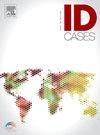Corynebacterium striatum as a rare cause of septic arthritis in a native joint: A case report and review of the literature
IF 1
Q4 INFECTIOUS DISEASES
引用次数: 0
Abstract
Septic arthritis commonly occurs due to gram-positive cocci and usually presents as acute monoarticular swelling and tenderness, often associated with systemic signs of sepsis. In rare scenarios, Corynebacterium striatum, a gram-positive bacillus, can cause septic arthritis. We present a rare case of native joint septic arthritis caused by C. striatum in an immunocompetent patient. A 74-year-old man with history of ESRD receiving HD presented with hematuria. He was found to have anemia and pyuria and was admitted for management of hematuria and UTI with ceftriaxone. Five days later, he developed new persistent fever and worsening leukocytosis, while receiving antibiotics. Examination revealed right knee swelling, erythema, and tenderness, with decreased range of motion. X-ray showed joint effusion for which he underwent right knee arthrocentesis and aspiration. Synovial fluid culture grew C. striatum, initially disregarded as a contaminant. Repeat cultures again grew C. striatum. He was treated with IV vancomycin and oral colchicine along with arthroscopic irrigation and debridement, and discharged on a 4-week course of vancomycin. C. striatum is typically a considered pathogen in immunocompromised individuals; however, emerging reports describe its role in infections among immunocompetent hosts. While C. striatum remains a rare cause of native joint septic arthritis, its isolation in multiple specimens in the appropriate clinical context should prompt clinicians to consider a true infection rather than contamination. Prompt identification and appropriate management is key to improving patient outcomes. Susceptibility testing helps guide targeted treatment for this emerging pathogen with increasing multi-drug resistance.
纹状棒状杆菌作为一种罕见的原因,败血性关节炎在天然关节:一个病例报告和文献复习
脓毒性关节炎通常由革兰氏阳性球菌引起,通常表现为急性单关节肿胀和压痛,通常伴有全身败血症症状。在罕见的情况下,纹状棒状杆菌,一种革兰氏阳性杆菌,可引起脓毒性关节炎。我们提出了一个罕见的情况下,原生关节化脓性关节炎引起的纹状体C.在免疫能力的病人。一名74岁男性,有ESRD病史,接受HD治疗,表现为血尿。他被发现有贫血和脓尿,并入院治疗血尿和尿路感染头孢曲松。5天后,在接受抗生素治疗期间,患者再次出现持续发热和白细胞增多。检查显示右膝肿胀、红斑和压痛,活动范围减小。x线显示关节积液,他接受了右膝关节穿刺和抽吸。滑液培养生长纹状体,最初被认为是一种污染物。重复培养再次生长纹状体。患者给予静脉万古霉素和口服秋水仙碱治疗,同时进行关节镜冲洗和清创术,并在万古霉素治疗4周后出院。纹状体通常被认为是免疫功能低下个体的病原体;然而,新出现的报告描述了它在免疫能力强的宿主感染中的作用。虽然纹状体梭状体仍然是一种罕见的原因,天然关节脓毒性关节炎,它的分离在多个标本在适当的临床背景下,应提示临床医生考虑真正的感染,而不是污染。及时识别和适当管理是改善患者预后的关键。药敏试验有助于指导对这种多药耐药性日益增加的新发病原体进行有针对性的治疗。
本文章由计算机程序翻译,如有差异,请以英文原文为准。
求助全文
约1分钟内获得全文
求助全文

 求助内容:
求助内容: 应助结果提醒方式:
应助结果提醒方式:


